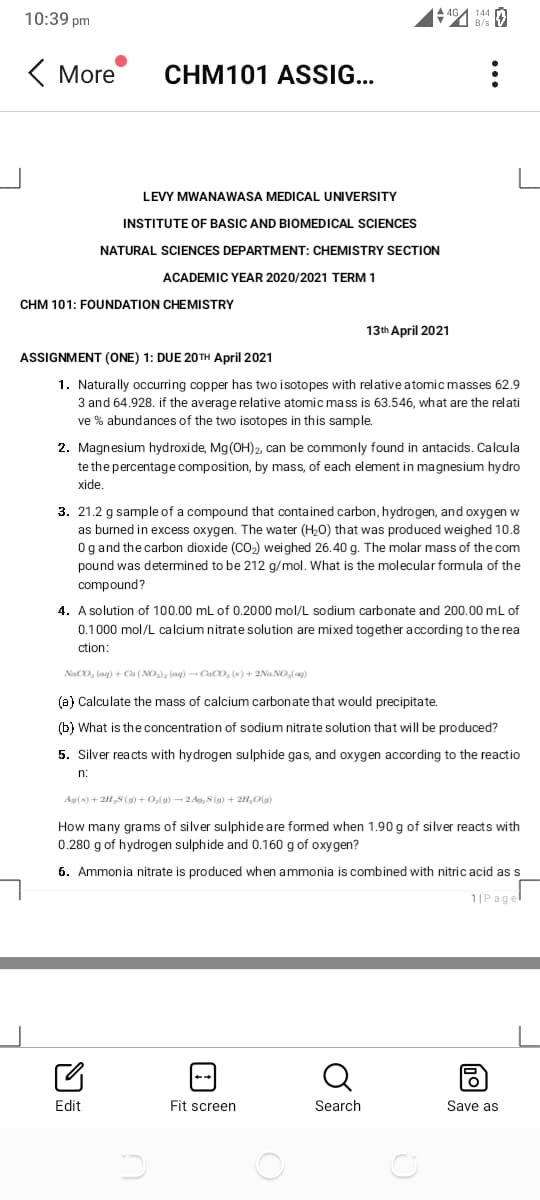1. Naturally occurring copper has two isotopes with relative atomic masses 62.9 3 and 64.928. if the average relative atomic mass is 63.546, what are the relat ve % abundances of the two isotopes in this sample. 2. Magnesium hydroxide, Mg(OH)2, can be commonly found in antacids. Calcula te the percentage composition, by mass, of each element in magnesium hydro
1. Naturally occurring copper has two isotopes with relative atomic masses 62.9 3 and 64.928. if the average relative atomic mass is 63.546, what are the relat ve % abundances of the two isotopes in this sample. 2. Magnesium hydroxide, Mg(OH)2, can be commonly found in antacids. Calcula te the percentage composition, by mass, of each element in magnesium hydro
Chemistry & Chemical Reactivity
10th Edition
ISBN:9781337399074
Author:John C. Kotz, Paul M. Treichel, John Townsend, David Treichel
Publisher:John C. Kotz, Paul M. Treichel, John Townsend, David Treichel
Chapter2: Atoms Molecules And Ions
Section: Chapter Questions
Problem 11PS: Marie Curie was born in Poland but studied and carried out her research in Paris. In 1903, she...
Related questions
Question
100%
Help me answer question 1-5 with all the necessary steps

Transcribed Image Text:10:39 pm
( More
CHM101 ASSIG..
LEVY MWANAWASA MEDICAL UNIVERSITY
INSTITUTE OF BASIC AND BIOMEDICAL SCIENCES
NATURAL SCIENCES DEPARTMENT: CHEMISTRY SECTION
ACADEMIC YEAR 2020/2021 TERM 1
CHM 101: FOUNDATION CHEMISTRY
13th April 2021
ASSIGNMENT (ONE) 1: DUE 20TH April 2021
1. Naturally occurring copper has two isotopes with relativeatomic masses 62.9
3 and 64.928. if the average relative atomic mass is 63.546, what are the relati
ve % abundances of the two isotopes in this sample.
2. Magnesium hydroxide, Mg(OH)2, can be commonly found in antacids. Calcula
te the percentage composition, by mass, of each element in magnesium hydro
xide.
3. 21.2 g sample of a compound that contained carbon, hydrogen, and oxygen w
as burned in excess oxygen. The water (H0) that was produced weighed 10.8
Ogand the carbon dioxide (CO2) weighed 26.40 g. The molar mass of the com
pound was determined to be 212 g/mol. What is the molecular formula of the
compound?
4. A solution of 100.00 mL of 0.2000 mol/L sodium carbonate and 200.00 mL of
0.1000 mol/L calcium nitrate solution are mixed together according to the rea
ction:
NaCO, (ag) + Ca (NO), (ag) - Caco, (s) + 2Na NO,(ag)
(a) Calculate the mass of calcium carbonate that would precipitate.
(b) What is the concentration of sodium nitrate solution that will be produced?
5. Silver reacts with hydrogen sulphide gas, and oxygen according to the reactio
n:
Ag(s) + 2H S(9) +0,l9) -2Ao, S (g) + 2H,0(g)
How many grams of silver sulphide are formed when 1.90 g of silver reacts with
0.280 g of hydrogen sulphide and 0.160 g of oxygen?
6. Ammonia nitrate is produced when ammonia is combined with nitric acid as s
1|Pagel
Q
Edit
Fit screen
Search
Save as
Expert Solution
This question has been solved!
Explore an expertly crafted, step-by-step solution for a thorough understanding of key concepts.
This is a popular solution!
Trending now
This is a popular solution!
Step by step
Solved in 2 steps with 1 images

Knowledge Booster
Learn more about
Need a deep-dive on the concept behind this application? Look no further. Learn more about this topic, chemistry and related others by exploring similar questions and additional content below.Recommended textbooks for you

Chemistry & Chemical Reactivity
Chemistry
ISBN:
9781337399074
Author:
John C. Kotz, Paul M. Treichel, John Townsend, David Treichel
Publisher:
Cengage Learning

Chemistry & Chemical Reactivity
Chemistry
ISBN:
9781133949640
Author:
John C. Kotz, Paul M. Treichel, John Townsend, David Treichel
Publisher:
Cengage Learning

Chemistry: Principles and Reactions
Chemistry
ISBN:
9781305079373
Author:
William L. Masterton, Cecile N. Hurley
Publisher:
Cengage Learning

Chemistry & Chemical Reactivity
Chemistry
ISBN:
9781337399074
Author:
John C. Kotz, Paul M. Treichel, John Townsend, David Treichel
Publisher:
Cengage Learning

Chemistry & Chemical Reactivity
Chemistry
ISBN:
9781133949640
Author:
John C. Kotz, Paul M. Treichel, John Townsend, David Treichel
Publisher:
Cengage Learning

Chemistry: Principles and Reactions
Chemistry
ISBN:
9781305079373
Author:
William L. Masterton, Cecile N. Hurley
Publisher:
Cengage Learning

Introduction to General, Organic and Biochemistry
Chemistry
ISBN:
9781285869759
Author:
Frederick A. Bettelheim, William H. Brown, Mary K. Campbell, Shawn O. Farrell, Omar Torres
Publisher:
Cengage Learning

